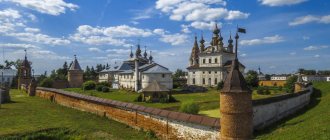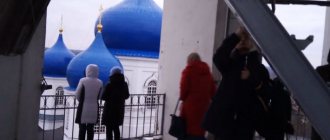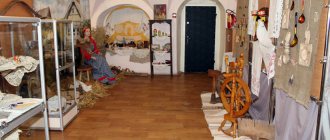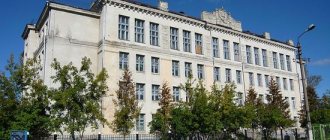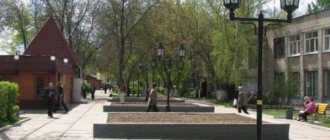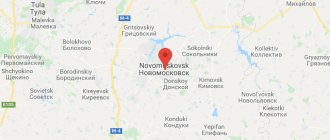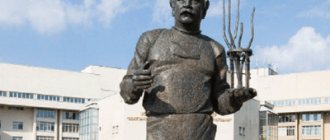This term has other meanings, see Yuryev-Polsky (meanings).
This term has other meanings, see Yuriev.
| City Yuriev-Polsky Coat of arms |
| A country | Russia, Russia |
| Subject of the federation | Vladimir regionVladimir region |
| Municipal district | Yuriev-Polsky |
| urban settlement | City of Yuryev-Polsky |
| Coordinates | 56°30′00″ n. w. 39°41′00″ E. d. / 56.50000° n. w. 39.68333° E. d. / 56.50000; 39.68333 (G) [www.openstreetmap.org/?mlat=56.50000&mlon=39.68333&zoom=12 (O)] (Z)Coordinates: 56°30′00″ N. w. 39°41′00″ E. d. / 56.50000° n. w. 39.68333° E. d. / 56.50000; 39.68333 (G) [www.openstreetmap.org/?mlat=56.50000&mlon=39.68333&zoom=12 (O)] (I) |
| Chapter | Ivanov Vladimir Mikhailovich |
| First mention | 1152 |
| City with | 1778 |
| Square | 10 km² |
| Center height | 140 |
| Population | ↘18,737[1] people (2016) |
| Density | 1,960 people/km² |
| Names of residents | Yuryevpoltsy, Yuryevpolets; Yuryevtsy, Yuryevets[2] |
| Timezone | UTC+3 |
| Telephone code | +7 49246 |
| Postcode | 601800 |
| Vehicle code | 33 |
| OKATO code | [classif.spb.ru/classificators/view/okt.php?st=A&kr=1&kod=17256501 17 256 501] |
| Official site | [yuriev-polskiy.ru polskiy.ru] |
Audio, photo and video
on Wikimedia Commons
Yuriev-Polsky
(
Yuryev-Polskoy
) is a city (since 1152[3]) in Russia, the administrative center of the Yuryev-Polsky district of the Vladimir region.
Population - 18,737[1] people. (2016).
Name
In the chronicles, the city was originally called Gyurgev or Gergev - after its founder Yuri Dolgoruky. The second part of the name - from the word “field”, the city stands on the Suzdal opole - appeared to clarify the location, due to the existence of other cities with the same name during this period: until 1224 - Yuryev (Tartu), and from 1224 - Yuryev- Povolsky (Yuryevets), Yuryev in the Dnieper region, located in the southern patrimony of the Suzdal princes (now the city of Belaya Tserkov).
The parallelism of the names “Yuryev-Polskaya” and “Yuryev-Polsky” is recorded, in particular, in the form of two spelling options for the name of the city in the TSB. Currently, on all maps and in official documents the city is called Yuryev-Polsky.
Where to go in Yuryev-Polsky with children
For a child, there is, frankly speaking, very little entertainment in the city of Yuryev-Polsky. But you can still find a place where children will have fun.
Children's entertainment
- Address: Krasnooktyabrskaya st., 1A.
In the city center, next to the City Market, this leisure center offers some memorable activities for children. The townspeople regularly bring their hell here, judging by the reviews, because in fact there are few such facilities here. Children are brought here with their parents so that they can look after their children. Soft blocks, small trampolines, inflatable slides, a dry pool with toys - all this is waiting for your child.
Victory Park
Photo: © https://maps.google.com/maps/contrib/109502934084084867793
- Coordinates on the map: 56.508516, 39.664045.
Probably the most famous public garden in the city, its only competitor - the Ganshin City Estate Park - offers practically nothing for family recreation, presenting a pitiful sight. However, in Victory Park there is also not much interesting for children. But here, on the banks of the beautiful Koloksha River, the breath is simply amazing, and the photos against the backdrop of natural beauty are memorable.
See also the sights of other cities of the Vladimir region - Alexandrov, Kirzhach, Petushkov, Sudogda, Kolchugino, Kidekshi, Vyaznikov, Bogolyubovo, Murom and Suzdal
Yuriev-Polsky is a reflection of different eras. Like an ancient elder, he wisely looks at modernity and invites you to take a break from the external bustle, to reflect on the passage of time and your existence in the vast world. Yuryev-Polsky is perfect for everyone who wants to dive into the depths of centuries and look at life with different eyes.
Story
The city was founded in 1152 by Yuri Dolgoruky. By his order, an almost circular fortress was built, which was surrounded by earthen ramparts up to 7 m high that have survived to this day, with wooden walls. In the center of the fortress, St. George's Cathedral was erected in 1234.
Since 1212, Yuryev-Polsky has been the center of an appanage principality, headed by Vsevolod’s son Svyatoslav the Big Nest. During his reign, the princely St. Michael the Archangel Monastery was founded in the city fortress.
In 1216, the famous Battle of Lipitsa took place near the city.
In 1238, 1382 and 1408 the city was devastated by the Mongol-Tatar invasion. In 1340 it became part of the great Moscow Principality.
During the unrest of the early 17th century, Yuryev-Polsky was burned by the Poles. From the middle of the 17th century, the economic growth of the city began, which was facilitated by its location on the Great Stromynskaya Road, which connected the Suzdal lands with Moscow.
In the 17th-18th centuries, the ensemble of the Archangel Michael Monastery was rebuilt, in which the gate Theological Church of 1670, located in the western part of the monastery fence, as well as the monumental hipped bell tower of the 17th century and the Znamenskaya Refectory Church stand out.
Since 1708 - as part of the Moscow province (county town since 1778), since 1796 - in the Vladimir province[4].
On July 11, 1919, government institutions of the city were looted by a gang of the staff captain of the tsarist army, Efim Skorodumov (Yushka).
In 1920, the Yuryev-Polsky Historical, Architectural and Art Museum was founded.
Until 2010, Yuryev-Polsky had the status of a historical settlement, but by Order of the Ministry of Culture of the Russian Federation of July 29, 2010 N 418/339, the city was deprived of this status[5].
St. George's Cathedral.
St. George's Cathedral is perhaps the last stone structure of the pre-Mongol period on the Vladimir-Suzdal land. All the innovative solutions of white stone architecture by local craftsmen found expression in it. The system of sculptural decoration, closely connected with the architectural appearance, “expressed a pre-thought-out plan - the idea of the grandeur and beauty of the universe, compared with the power and prosperity of the Vladimir-Suzdal land led by its princes” - this is how G. K. Wagner spoke about the temple. Even in the form that has come down to us, modified by perestroika, St. George's Cathedral remains the unsurpassed pinnacle of great ancient Russian art, an example of a wonderful synthesis of architecture and sculpture.
Population
City population dynamics[6][7][8][8][9][10][11][12][13][14]:
ImageSize = width:700 height:300 PlotArea = left:50 right:40 top:20 bottom:20 TimeAxis = orientation:vertical AlignBars = justify Colors =
id:gray1 value:gray(0.9)
DateFormat = yyyy Period = from:0 till:22247 ScaleMajor = unit:year increment:5000 start:0 gridcolor:gray1 PlotData =
bar:1859 color:gray1 width:1 from:0 till:4279 width:15 text:4279 textcolor:red fontsize:8px bar:1897 color:gray1 width:1 from:0 till:5759 width:15 text:5759 textcolor: red fontsize:8px bar:1926 color:gray1 width:1 from:0 till:8100 width:15 text:8100 textcolor:red fontsize:8px bar:1939 color:gray1 width:1 from:0 till:15200 width:15 text :15 200 textcolor:red fontsize:8px bar:1959 color:gray1 width:1 from:0 till:16801 width:15 text:16 801 textcolor:red fontsize:8px bar:1970 color:gray1 width:1 from:0 till :22096 width:15 text:22 096 textcolor:red fontsize:8px bar:1979 color:gray1 width:1 from:0 till:21091 width:15 text:21 091 textcolor:red fontsize:8px bar:1989 color:gray1 width :1 from:0 till:22247 width:15 text:22 247 textcolor:red fontsize:8px bar:2002 color:gray1 width:1 from:0 till:19906 width:15 text:19 906 textcolor:red fontsize:8px bar :2010 color:gray1 width:1 from:0 till:19595 width:15 text:19 595 textcolor:red fontsize:8px
Attractions
Yuryev-Polsky is part of the Golden Ring of Russia. The most famous architectural monuments of the city:
- Michael the Archangel Monastery (XVII century) with a cathedral (1792)
- Znamenskaya Church (1625)
- St. George's Cathedral (1230-1234, reconstruction of the 15th century).
- Remains of the ramparts of the Yuryev-Polsky Kremlin of the 12th century.
- Church of the Nativity of Christ from the 18th century.
- Temple of Nikita the Martyr of the 18th century.
Nearby, in the village of Sima (known since the 14th century) is the former estate of the Golitsyn princes; here in September 1812, the hero of the Patriotic War, General P. I. Bagration, died.
|
Architecture and beautiful buildings
Yuryev-Polsky is a place of contrasts. Typical five-story buildings alternate with ancient buildings, thanks to which you can trace the development of urban architecture from ancient times to the present day.
Shopping arcades
- Address: pl. Soviet.
Trading premises, traditional for many Russian cities, appeared in Yuryev-Polsky in the 18th century. A hundred years later, a strong fire destroyed the wooden buildings, and soon a new building arose in their place, which has survived to this day. The Yuriev-Polsky ranks made a small contribution to domestic cinema: in the 60s of the last century, the film “The Golden Calf” with S. Yursky in the title role was filmed here. While walking along the Trade Rows, tourists can do two pleasant and useful things at once - examine the architectural monument and buy the necessary goods in the shops located in it.
Barn
- Address: per. Avangardsky, 3.
The unremarkable red building made of simple brick is an architectural monument of the 19th century. For a long time, merchant goods were stored here, but during the years of “dekulakization” the building was recognized as socialist property and turned into a city warehouse.
Fire station
- Address: Vladimirskaya st., 12.
The interesting brick building in the Gothic style has been well preserved despite its hundred years of age. The depot has been used for its intended purpose at all times, under any government. In some rooms dance evenings and theatrical performances were held, in others fire engines were waiting to be called. The gray building with its unusual shape stands out among other city buildings.
Almshouse of the Meshcherins
- Address: st. May 1st, 16.
The remarkable two-story red brick building was erected at the beginning of the 20th century with the money of local philanthropist G.I. Meshcherina. The almshouse accommodated more than 150 people of both sexes, mainly townspeople and old merchants. Currently, the former almshouse continues to benefit people: the central hospital of the region operates in the building.
Shevelkin Inn
- Address: 1st May Street, 33.
Good, memorable photos are also taken against the backdrop of this architectural landmark of Yuryev-Polsky. The building of the Shevelkins' inn was built approximately at the end of the 19th century, in the form of a two-story building with a blue and white facade and beautiful, bordered windows. The entrance is crowned by a pretty porch.
Khlebnikov's shop
- Address: st. 1st May, 4.
In the central part of the city, almost every building is an object of cultural heritage of municipal or federal significance. So is the former Khlebnikov Shop, built in the 19th century and a decoration of the city limits. As before, today there is a store offering food products here.
Notable natives
- Nikon of Radonezh (1350-1426) - Venerable. Holy Russian Orthodox Church. The second abbot of the Trinity-Sergius Monastery after St. Sergius of Radonezh.
- Sokolov, Andrei Konstantinovich (1941-2015) - Soviet and Russian historian, specialist in the field of source studies and methodology of modern Russian history.
- Fomin, Nikolai Sergeevich (1895-1987) - Soviet military leader, Colonel General of Artillery. Hero of the Soviet Union.
- Yakimovich, Roman (1889-1951) - Polish archaeologist.
Notes
- ↑ 12
www.gks.ru/free_doc/doc_2016/bul_dr/mun_obr2016.rar Population of the Russian Federation by municipalities as of January 1, 2021 - Gorodetskaya I. L., Levashov I. A.
Russian names of residents: Dictionary-reference book / Ed. E. A. Levashova. - M.: Russian dictionaries, 2003. - P. 341. - ISBN 5-93259-033-5. - THE USSR. Administrative-territorial division of the union republics on January 1, 1980 / Compiled by V. A. Dudarev, N. A. Evseeva. - M.: Publishing house "Izvestia of the Soviets of People's Deputies of the USSR", 1980. - 702 p. — P. 106.
- Yuryev, district town of Vladimir province // Encyclopedic Dictionary of Brockhaus and Efron: in 86 volumes (82 volumes and 4 additional). - St. Petersburg, 1890-1907.
- [www.rg.ru/2010/09/29/istor-posel-dok.html Order of the Ministry of Culture of the Russian Federation, Ministry of Regional Development of the Russian Federation dated July 29, 2010 N 418/339 Moscow “On approval of the list of historical settlements "]
- Vladimir province. List of populated places according to information from 1859.
- [demoscope.ru/weekly/ssp/rus_gub_97.php?reg=6 First General Census of the Russian Empire in 1897]. [www.webcitation.org/61970XvLT Archived from the original on August 23, 2011].
- ↑ 12
Cities of Russia: encyclopedia / Ch. ed. G. M. Lappo. - M.: Great Russian Encyclopedia, 1994. - [www.webgeo.ru/db/1959/rus-1.htm All-Union Population Census of 1959]. [www.webcitation.org/61971ZEds Archived from the original on August 23, 2011].
- [www.webgeo.ru/db/1970/rus-centr.htm All-Union Population Census of 1970]. [www.webcitation.org/619725wY0 Archived from the original on August 23, 2011].
- [www.webgeo.ru/db/1979/rus-centr.htm All-Union Population Census of 1979]. [www.webcitation.org/61972YvK1 Archived from the original on August 23, 2011].
- [demoscope.ru/weekly/ssp/rus89_reg2.php All-Union Population Census 1989]. [www.webcitation.org/617x0o0Pa Archived from the original on August 22, 2011].
- [demoscope.ru/weekly/ssp/rus02_reg1.php All-Russian Population Census 2002]. [www.webcitation.org/618gocsZV Archived from the original on August 23, 2011].
- [www.gks.ru/free_doc/new_site/perepis2010/croc/Documents/Vol1/pub-01-11.pdf All-Russian Population Census 2010]
- [vladtv.ru/state/21918/ Yuryev-Polsky has its first sister city]. State Television and Radio Broadcasting Company "Vladimir". Retrieved May 6, 2012. [www.webcitation.org/68gppwBnf Archived from the original on June 25, 2012].
- [www.automobili.ru/magazine/2011/04/48_hours/travel_and_sport/1008/ Yuryev-Polsky is a city that will tell about itself]. automobili.ru (April 2011). Retrieved December 24, 2014.
- [nasheopolie.ru/archives/828 Filming of a feature series called “Russian Chocolate” has been completed]. “Our Opole” (October 23, 2010). Retrieved December 24, 2014.
Literature
- Voronin N. N.
Vladimir. Bogolyubovo. Suzdal. Yuryev-Polskoy: A companion book to the ancient cities of the Vladimir land. 5th ed. - M.: Art, 1983. - (Architectural and artistic monuments of cities of the USSR). - Nevolin P.I.
Yuryev, district town of Vladimir province // Encyclopedic Dictionary of Brockhaus and Efron: in 86 volumes (82 volumes and 4 additional). - St. Petersburg, 1890-1907. - Monuments of history and culture of the Vladimir region: Catalog / Compiled by: V. A. Kostkin and others. State. center for registration, use and restoration of historical and cultural monuments of the Vladimir region. - Vladimir: Pokrov Publishing House, 1996. - 520, [72] p. — 5,000 copies. — ISBN 5-87393-004-X..
Excerpt characterizing Yuriev-Polsky
Anna Mikhailovna was already hugging her and crying. The Countess cried too. They cried that they were friends; and that they are good; and that they, friends of youth, are busy with such a low subject - money; and that their youth had passed... But the tears of both were pleasant... Countess Rostova with her daughters and already with a large number of guests was sitting in the living room. The Count led the male guests into his office, offering them his hunting collection of Turkish pipes. Occasionally he would go out and ask: has she arrived? They were waiting for Marya Dmitrievna Akhrosimova, nicknamed in society le terrible dragon, [a terrible dragon,] a lady famous not for wealth, not for honors, but for her directness of mind and frank simplicity of manner. Marya Dmitrievna was known by the royal family, all of Moscow and all of St. Petersburg knew her, and both cities, surprised by her, secretly laughed at her rudeness and told jokes about her; nevertheless, everyone without exception respected and feared her. In the office, full of smoke, there was a conversation about the war, which was declared by the manifesto, about recruitment. No one had read the manifesto yet, but everyone knew about its appearance. The Count was sitting on an ottoman between two neighbors who were smoking and talking. The count himself did not smoke or speak, but tilting his head, now to one side, now to the other, looked with visible pleasure at those smoking and listened to the conversation of his two neighbors, whom he pitted against each other. One of the speakers was a civilian, with a wrinkled, bilious and shaved thin face, a man already approaching old age, although dressed like the most fashionable young man; he sat with his feet on the ottoman with the air of a domestic man and, throwing amber far into his mouth from the side, impulsively inhaled the smoke and squinted. It was the old bachelor Shinshin, the countess's cousin, an evil tongue, as they said about him in Moscow drawing rooms. He seemed to condescend to his interlocutor. Another, fresh, pink, guards officer, impeccably washed, buttoned up and combed, held amber in the middle of his mouth and lightly pulled out smoke with his pink lips, releasing it in ringlets from his beautiful mouth. This was Lieutenant Berg, an officer of the Semenovsky regiment, with whom Boris rode together in the regiment and with whom Natasha teased Vera, the senior countess, calling Berg her fiancé. The Count sat between them and listened attentively. The most enjoyable activity for the Count, with the exception of the game of Boston, which he loved very much, was the position of listening, especially when he managed to pit two talkative interlocutors against each other. “Well, of course, father, mon tres honorable [most venerable] Alfons Karlych,” said Shinshin, laughing and combining (which was the peculiarity of his speech) the most popular Russian expressions with refined French phrases. – Vous comptez vous faire des rentes sur l'etat, [You expect to have income from the treasury,] do you want to receive income from the company? - No, Pyotr Nikolaich, I just want to show that cavalry has much less benefits against infantry. Now imagine, Pyotr Nikolaich, my situation... Berg always spoke very precisely, calmly and courteously. His conversation always concerned himself alone; he always remained calmly silent while they were talking about something that had nothing directly to do with him. And he could remain silent in this way for several hours without experiencing or causing the slightest confusion in others. But as soon as the conversation concerned him personally, he began to speak at length and with visible pleasure. - Consider my position, Pyotr Nikolaich: if I were in the cavalry, I would receive no more than two hundred rubles a third, even with the rank of lieutenant; and now I get two hundred and thirty,” he said with a joyful, pleasant smile, looking at Shinshin and the count, as if it was obvious to him that his success would always be the main goal of the desires of all other people. “Besides, Pyotr Nikolaich, having joined the guard, I am visible,” Berg continued, “and vacancies in the guards infantry are much more frequent.” Then, figure out for yourself how I could make a living out of two hundred and thirty rubles. “And I’m putting it aside and sending it to my father,” he continued, starting the ring. “La balance y est... [The balance is established...] A German is threshing a loaf of bread on the butt, comme dit le proverbe, [as the proverb says],” Shinshin said, shifting the amber to the other side of his mouth and winked at the count. The Count burst out laughing. Other guests, seeing that Shinshin was talking, came up to listen. Berg, not noticing either ridicule or indifference, continued to talk about how by transferring to the guard he had already won a rank in front of his comrades in the corps, how in wartime a company commander can be killed, and he, remaining senior in the company, can very easily be company commander, and how everyone in the regiment loves him, and how his daddy is pleased with him. Berg apparently enjoyed telling all this, and did not seem to suspect that other people might also have their own interests. But everything he told was so sweetly sedate, the naivety of his young egoism was so obvious that he disarmed his listeners. - Well, father, you will be in action in both the infantry and the cavalry; “This is what I predict for you,” said Shinshin, patting him on the shoulder and lowering his legs from the ottoman. Berg smiled happily. The Count, followed by the guests, went into the living room. There was that time before a dinner party when the assembled guests do not begin a long conversation in anticipation of the call for appetizers, but at the same time consider it necessary to move and not remain silent in order to show that they are not at all impatient to sit down at the table. The owners glance at the door and occasionally glance at each other. From these glances, guests try to guess who or what else they are waiting for: an important relative who is late, or food that is not yet ripe. Pierre arrived just before dinner and sat awkwardly in the middle of the living room on the first available chair, blocking everyone's path. The Countess wanted to force him to speak, but he naively looked through his glasses around him, as if looking for someone, and answered all the Countess’s questions in monosyllables. He was shy and alone did not notice it. Most of the guests, who knew his story with the bear, looked curiously at this big, fat and humble man, wondering how such a bumpkin and modest man could do such a thing to a policeman. -Have you arrived recently? - the countess asked him. “Oui, madame,” he answered, looking around. -Have you seen my husband? - Non, madame. [No, madam.] - He smiled completely inappropriately. – You, it seems, were recently in Paris? I think it's very interesting. – Very interesting.. The Countess exchanged glances with Anna Mikhailovna. Anna Mikhailovna realized that she was being asked to occupy this young man, and, sitting down next to him, began to talk about her father; but just like the countess, he answered her only in monosyllables. The guests were all busy with each other. Les Razoumovsky... ca a ete charmant... Vous etes bien bonne... La comtesse Apraksine... [The Razoumovskys... It was amazing... You are very kind... Countess Apraksina...] was heard from all sides. The Countess got up and went into the hall. - Marya Dmitrievna? – her voice was heard from the hall. “She’s the one,” a rough female voice was heard in response, and after that Marya Dmitrievna entered the room. All the young ladies and even the ladies, with the exception of the oldest ones, stood up. Marya Dmitrievna stopped at the door and, from the height of her corpulent body, holding high her fifty-year-old head with gray curls, looked around at the guests and, as if rolling up, slowly straightened the wide sleeves of her dress. Marya Dmitrievna always spoke Russian. “Dear birthday girl with the children,” she said in her loud, thick voice, suppressing all other sounds. “What, you old sinner,” she turned to the count, who was kissing her hand, “tea, are you bored in Moscow?” Is there anywhere to run the dogs? What should we do, father, this is how these birds will grow up...” She pointed to the girls. - Whether you want it or not, you have to look for suitors. - Well, what, my Cossack? (Marya Dmitrievna called Natasha a Cossack) - she said, caressing Natasha with her hand, who approached her hand without fear and cheerfully. – I know that the potion is a girl, but I love her. She took out pear-shaped yakhon earrings from her huge reticule and, giving them to Natasha, who was beaming and blushing for her birthday, immediately turned away from her and turned to Pierre. - Eh, eh! kind! “Come here,” she said in a feignedly quiet and thin voice. - Come on, my dear... And she menacingly rolled up her sleeves even higher. Pierre approached, naively looking at her through his glasses. - Come, come, my dear! I was the only one who told your father the truth when he had a chance, but God commands it to you. She paused. Everyone was silent, waiting for what would happen, and feeling that there was only a preface. - Good, nothing to say! good boy!... The father is lying on his bed, and he is amusing himself, putting the policeman on a bear. It's a shame, father, it's a shame! It would be better to go to war. She turned away and offered her hand to the count, who could hardly restrain himself from laughing. - Well, come to the table, I have tea, is it time? - said Marya Dmitrievna. The count walked ahead with Marya Dmitrievna; then the countess, who was led by a hussar colonel, the right person with whom Nikolai was supposed to catch up with the regiment. Anna Mikhailovna - with Shinshin. Berg shook hands with Vera. A smiling Julie Karagina went with Nikolai to the table. Behind them came other couples, stretching across the entire hall, and behind them, one by one, were children, tutors and governesses. The waiters began to stir, the chairs rattled, music began to play in the choir, and the guests took their seats. The sounds of the count's home music were replaced by the sounds of knives and forks, the chatter of guests, and the quiet steps of waiters. At one end of the table the countess sat at the head. On the right is Marya Dmitrievna, on the left is Anna Mikhailovna and other guests. At the other end sat the count, on the left the hussar colonel, on the right Shinshin and other male guests. On one side of the long table are older young people: Vera next to Berg, Pierre next to Boris; on the other hand - children, tutors and governesses. From behind the crystal, bottles and vases of fruit, the Count looked at his wife and her tall cap with blue ribbons and diligently poured wine for his neighbors, not forgetting himself. The countess also, from behind the pineapples, not forgetting her duties as a housewife, cast significant glances at her husband, whose bald head and face, it seemed to her, were more sharply different from his gray hair in their redness. There was a steady babble on the ladies' end; in the men's room, voices were heard louder and louder, especially the hussar colonel, who ate and drank so much, blushing more and more, that the count was already setting him up as an example to the other guests. Berg, with a gentle smile, spoke to Vera that love is not an earthly, but a heavenly feeling. Boris named his new friend Pierre the guests at the table and exchanged glances with Natasha, who was sitting opposite him. Pierre spoke little, looked at new faces and ate a lot. Starting from two soups, from which he chose a la tortue, [turtle,] and kulebyaki and to hazel grouse, he did not miss a single dish and not a single wine, which the butler mysteriously stuck out in a bottle wrapped in a napkin from behind his neighbor’s shoulder, saying or “drey Madeira", or "Hungarian", or "Rhine wine". He placed the first of the four crystal glasses with the count's monogram that stood in front of each device, and drank with pleasure, looking at the guests with an increasingly pleasant expression. Natasha, sitting opposite him, looked at Boris the way thirteen-year-old girls look at a boy with whom they had just kissed for the first time and with whom they are in love. This same look of hers sometimes turned to Pierre, and under the gaze of this funny, lively girl he wanted to laugh himself, not knowing why.
Yuryev (city)
Middle Ages
Foundation of the city
At the beginning of the 13th century there were no cities in the Baltic states, but in many places there were trades and fairs were held at certain traditional times. Each trade of any size was protected by a special fortification, and, as a rule, near it (usually at the foot of a fortress or rampart) there was a settlement - a settlement. Almost all early Baltic cities developed on such sites[4]. Permanent human settlement[2] on Domskaya Hill dates back to the 5th century, the fort – to the 6th–8th centuries.
The first mention of a settlement on the site of modern Tartu is a chronicle story (1030), when the Grand Duke Yaroslav the Wise set off from Novgorod on a campaign against the Estonians and founded the city of Yuryev (named after the Christian name of the prince)[5]. According to the Tale of Bygone Years: “That same year Yaroslav went to Chud, and defeated them, and established the city of Yuryev”
. Historians suggest that the reason for Yaroslav’s campaign could have been the fact that the Estonians took the side of Knut, the king of Denmark and England, whose opponent Olaf the Fat, king of Norway, received help from Yaroslav[4].
The fortress founded by Yaroslav was located on the highest elevation of the swampy meadow floodplain of the Omovzha River. Here were trade routes connecting the north and south of Livonia, as well as the craft centers of Novgorod and Pskov with the harbors of Estonia and Vironia. During this period, numerous fortified settlements appeared; in their place, over time, a number of urban-type settlements were formed: Odenpe, Revel, Fellin and others. Priest N. Koger, who studied the history of Tartu, argued that Yaroslav built a church in the city in the name of St. George, which was destroyed by the crusaders in 1224, but there is information about the construction of another church in the name of St. Nicholas the Wonderworker. The story of the beginning of the founding of the Pskov-Pechersky Monastery, according to A. Sapunov, also speaks of the coexistence of the two churches [4][6][7][8].
After the death of Yaroslav the Wise
According to the chronicle, the city of Yuriev was burned[9] by local tribes (Ssols - representatives of the Estonian tribes of Sakalas or Saaremas)[9] in 1061[10] in order to get rid of the power of local Slavic princes. Apparently, the Slavic inhabitants who lived here also built typical houses for themselves - mansions, which are mentioned in the same chronicle[11]. In the Yuryevsky Zarechye, on the left bank of the Omovzha, a Slavic suburb was founded on a hill, which sources from the 15th century speak of as existing in the city on the right bank of the “Russian End”, which developed as a legally independent settlement that had its own administration, trading court and church[ 4]. 70 years later, on February 9, 1134, the city and its suburbs were captured by the Novgorod prince Vsevolod Mstislavich, and in the winter of 1194 by the Novgorod prince Yaroslav Vsevolodovich[9][4].
In 1211 it was once again burned by the Latgalians[9]. In 1215, Yuryev was captured by the German knights of the sword, but in 1223 it was captured from them by the Estonians as a result of a general uprising. For the subsequent defense of the Slavic suburb, a detachment of 200 people led by Prince Vyachko (Vyacheslav Borisovich) was sent from Novgorod to Yuryev. In 1224, after a long siege, Yuryev was taken by the Swordsmen. For stubborn resistance, the Germans executed all captured defenders of the city, Estonians and Slavs; The prince himself died or was executed[12], as evidenced by the first Novgorod chronicle:
That same summer, the Germans killed Prince Vyachka in Gyurgev and took the city[13].
- Novgorod first chronicle of the older and younger editions. Year 6732 (1224)
In the "Chronicles of Henry of Latvia" 1225-1227. the settlement is called Tarbata
,
Tharbata
,
Tharbete
and
Darbete
)[14]. Having renamed the city in German Dorpat, or Dorpat[15][16], the Catholic Bishop Hermann Buxhoeveden made it the center of his principality-bishopric. The city was the center of the bishopric for three centuries[17].
The fall of Yuryev had strategic consequences for the spread of the Slavic principalities in a western direction[18]:
With the fall of Yuryev, our ancient rule in Livonia ceases for a long time.
Capital of the Bishopric of Dorpat
In 1248 he was first mentioned as a participant in the Hanseatic trade. It was a full member of the Hanseatic League from 1276[17] until the mid-16th century; German merchants and artisans flocked here. Dorpat was of great importance in the trade of the Hanseatic League with Novgorod and Pskov. The main population of Dorpat were Baltic Germans. According to written sources, it is known about the coexistence of trade relations between Dorpat and Novgorod in the 13th-15th centuries. Judging by the documents, Dorpat played an important role in the Hansa, because it was mentioned in 2nd place after Riga.
In 1328, the Moscow Chronicle noted a big fire: “That same summer, the entire German city of Yuriev burned down, and the goddesses and stone platas fell, and the fire in the platas was 2000 Germans and 500 and 30, and 4 people in Rus'.”
Under the name "Yuryeva" the city is often mentioned in the Novgorod chronicles and in discharge records from the time of the Livonian War (1558-1583). At the beginning of the Livonian War, the garrison of Dorpat capitulated after the siege, and the city was taken by Russian troops. According to the Yam-Zapolsky Peace of 1582, it went to the Inflyantsky Voivodeship of the Polish-Lithuanian Commonwealth. In 1600 it was captured from it by the Swedes, and in 1603 the Polish-Lithuanian Commonwealth recaptured it. In 1625 the city was reoccupied by the Swedes. During the Russian-Swedish War in the summer of 1656, Dorpat was taken by the Russians, but after an unsuccessful two-month siege of Riga, they were forced to abandon both the city and Livonia.
17th century
In 1600-1603, 1625-1656 and 1661-1704 Dorpat belonged to Sweden, in 1603-1625 - to the Polish-Lithuanian Commonwealth, in 1656-1661 - to Russia.
Dorpat (Tartu) University. Main building (2006) Tartu, Rüütli street in the old town
In 1632, the Gustavian Academy was opened, the second university in the Kingdom of Sweden after Uppsala University (in the 18th century, after the annexation of Livonia to Russia, it ceased to exist).
XVIII - early XX centuries
In the summer of 1704, during the Northern War, Dorpat was taken by the Russian troops of Tsar Peter I[19][20].
For several years after the capture of the city, its inhabitants of Swedish nationality were largely resettled to the interior regions of Russia (for example, to Vologda)[21], but the Germans and Estonians remained in place.
In 1775, a gigantic fire destroyed the historical center of the city.
Since 1783, it has been a district town in the Livonia province and the administrative center of Dorpat district[19].
In 1802, by decree of Alexander I, the Imperial University of Dorpat was opened, which made the city the cultural and scientific center of the region. The charter of the university, approved by the emperor on June 4, 1820[22], states: “Established in the Russian Empire for the common good; especially for the benefit of the Livonia, Estonia and Courland Provinces, and therefore the university accepts as students people of all conditions, Russian natives and foreigners...” Teaching at the university was conducted in German.
The Estonian literary language was founded here (in the 19th century by Friedrich Kreutzwald) and periodical printing; in 1869, the first Song Festival[17][23] was held here, which was organized by a prominent figure in the Estonian national awakening, journalist, poet I. V. Jansen , and in 1870 the Estonian professional theater was born.
During the period of “de-marking” the Baltic region, carried out during the reign of Emperor Alexander III[19], in 1893 the name Yuryev
, which remained until 1919.
XX century
After the February Revolution of 1917, the Estonian Progressive People's Party, led by J. Tõnisson, sought to create a separate province from northern Livonia with its center in Yuryev[24]. On March 30, 1917, the Provisional Government of Russia approved the regulation “On the temporary structure of administrative management and local self-government of the Estonian province.” In accordance with it, the borders of the Livonia province were revised, Yuryevsky district, which was part of it, together with four other northern counties of Livonia with an Estonian rural population, were transferred to the Estonian province.
During the February Revolution on March 4 (17), 1917, the Council of Workers' Deputies was created in Yuryev, in which by September the majority belonged to the Bolsheviks. Soviet power was established peacefully on October 25 (November 7), 1917. Four months later, on February 24, 1918, the city was occupied by German troops. On December 22, 1918, the Red Army liberated it from the Germans and restored the power of the Council, which lasted 23 days until January 14, 1919[25].
On this day, Estonian national troops formed in Reval drove the Red Army out of Yuryev. In a short period of time, approximately 360 Russians were executed[26]. In the Estonian bourgeois republic the city was renamed Tartu
. On February 2, 1920, the Tartu Peace Treaty, which contained territorial concessions in favor of Estonia, was signed between the government of the Republic of Estonia and the government of the RSFSR, in which the parties recognized each other’s sovereignty[25].
In the years 1920–1940, Tartu was primarily the center of the academic and cultural life of the new Estonia.
In 1940, according to the Molotov-Ribbentrop Pact, Soviet troops were brought into Estonia and the ESSR was formed, whose leadership decided to join the USSR on August 6, 1940. Tartu State (formerly Imperial) University became a Soviet university with education in Estonian and Russian.
On the night of July 8-9, 1941, in the Tartu prison of the city, the NKVD shot 192 people detained since the outbreak of hostilities on June 22 of the same year. The very next day, July 10, 1941, the paramilitary society Forest Brothers began an uprising against the leadership of the ESSR in southern Estonia and the Tartu region[27]. On July 26, 1941, the city was occupied by German troops. The German-appointed rector of the University of Tartu, Professor Edgar Kant, ordered the dismissal of everyone who was hired after June 21, 1940, the throwing out of all communist literature from libraries and the removal of communist terminology from all official titles.
On August 25, 1944, during the Tartu operation of the troops of the 3rd Baltic Front, the city was occupied by the Red Army. During the war, Tartu suffered greatly from bombing: the Stone Bridge ( Kivisild
) across the Emajõgi River, the Vanemuine Theater building, the Estonian Folk Museum, the Church of St. John and St. Mary.
By 1950, the city's population had increased to 55 thousand people[17].
